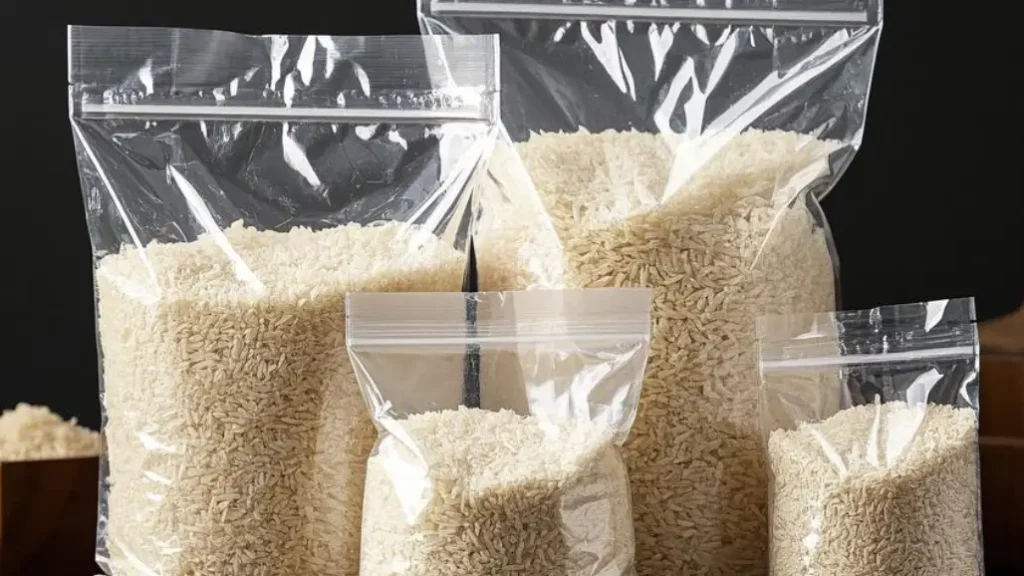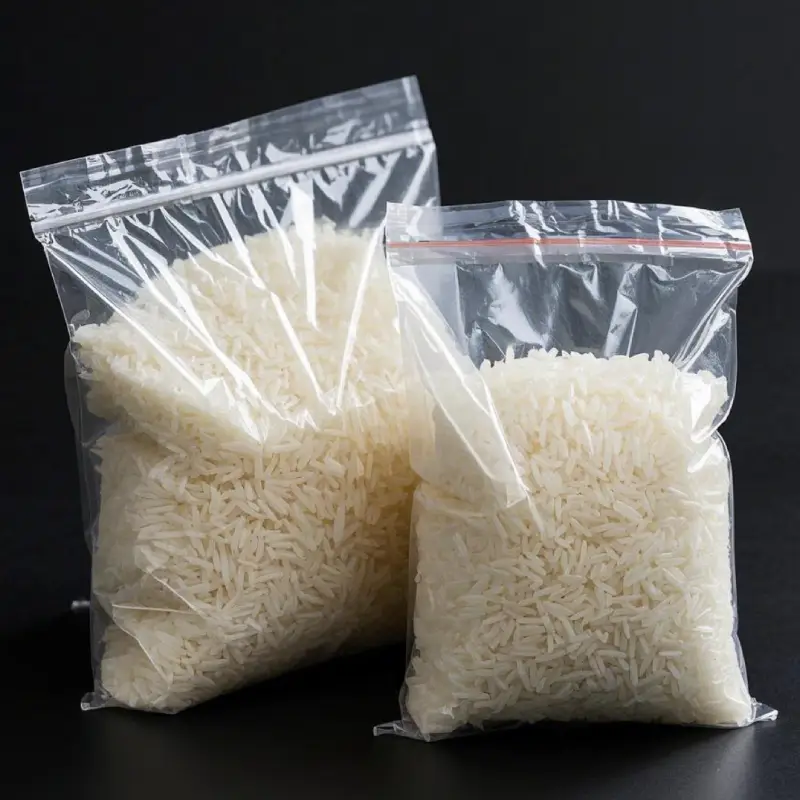Rice is a pantry staple, but its shelf life can be affected by storage conditions. For long-term storage, Mylar bags offer a superior solution compared to traditional methods. This blog post will explore how long rice lasts in Mylar bags, discussing the factors that influence its longevity and offering tips for maximizing its shelf life.
Understanding how to properly store rice is crucial for ensuring its quality and preventing spoilage. We’ll delve into the benefits of using Mylar bags and oxygen absorbers for rice storage, providing a comprehensive guide to help you keep your rice fresh and ready to use for years to come.
Can You Store Brown Rice in Mylar Bags

Yes, you can absolutely store brown rice in Mylar bags, and it’s a highly effective way to preserve its quality and extend its shelf life. Brown rice, like other grains, benefits significantly from the protective properties of Mylar bags, which create a barrier against oxygen, moisture, and light – the main factors that contribute to spoilage. When combined with oxygen absorbers, Mylar bags provide an ideal environment for long-term brown rice storage.
However, it’s important to note that brown rice has a shorter shelf life than white rice due to its higher oil content. This makes it more susceptible to rancidity over time. Therefore, while Mylar bags significantly extend its storage life, brown rice may not last quite as long as white rice under the same conditions. Nonetheless, with proper storage techniques, you can still keep brown rice fresh and usable for several years.
To maximize the shelf life of brown rice in Mylar bags, it’s crucial to use oxygen absorbers and properly heat-seal the bags. This combination removes as much oxygen as possible and creates an airtight environment, preventing any further oxygen or moisture from entering and compromising the rice’s quality. Additionally, storing the Mylar bags in a cool, dark, and dry place can further enhance their effectiveness. By following these steps, you can confidently store brown rice in Mylar bags and enjoy its nutritional benefits for an extended period.
How Long Does Rice Last in Mylar Bags
Rice is a pantry staple prized for its versatility and long shelf life. When stored correctly, it can last for years, making it a valuable addition to any food storage plan. However, the shelf life of rice in mylar bags varies depending on the type of rice and how it’s stored.
White Rice:
White rice, including varieties like long grain, jasmine, and basmati, is known for its exceptional longevity. When stored in Mylar bags with oxygen absorbers, white rice can last for an incredibly long time, potentially up to 30 years. This is because white rice has been processed to remove the bran and germ, which contain oils that can go rancid over time.
Brown Rice:
Brown rice, on the other hand, has a shorter shelf life than white rice due to its higher oil content. While still a nutritious option, brown rice is more susceptible to spoilage. Even when stored in Mylar bags with oxygen absorbers, brown rice typically lasts for a few years, rather than decades.
Rice Shelf Life Comparison:
| Rice Type | Storage Method | Approximate Shelf Life |
|---|---|---|
| White Rice (Long Grain, Jasmine, Basmati) | Mylar Bags with Oxygen Absorbers | Up to 30 years |
| White Rice (Long Grain, Jasmine, Basmati) | Airtight Container | Up to 2 years |
| Brown Rice | Mylar Bags with Oxygen Absorbers | A few years (2-5 years typically) |
| Brown Rice | Airtight Container | Up to 6 months |
By following these guidelines, you can confidently store rice for extended periods and enjoy its nutritional benefits whenever you need it.
Factors Affecting Shelf Life:
Several factors can influence the shelf life of rice, including:
- Type of rice: As mentioned above, white rice lasts significantly longer than brown rice.
- Storage conditions: Cool, dark, and dry environments are ideal for storing rice. Avoid areas with high humidity or fluctuating temperatures.
- Packaging: Mylar bags with oxygen absorbers provide the best protection against oxygen, moisture, and light, which can degrade rice quality.
Recommendations:
To maximize the shelf life of rice, follow these recommendations:
- Choose the right type: If long-term storage is your goal, opt for white rice.
- Use Mylar bags: Store rice in high-quality Mylar bags with oxygen absorbers.
- Properly seal: Ensure the bags are heat-sealed to create an airtight barrier.
- Store in a cool, dark place: Keep the Mylar bags in a cool, dark, and dry location.
By following these guidelines, you can confidently store rice for extended periods and enjoy its nutritional benefits whenever you need it.
How Many Cups of Rice in 1 Gallon Mylar Bag

It’s tricky to give an exact number of cups of rice that will fit in a 1-gallon Mylar bag because it depends on a few factors. These include the type of rice (long grain, short grain, etc.), how densely you pack it, and the specific dimensions of your Mylar bag. However, we can make a reasonable estimate.
General Estimate:
A good rule of thumb is that a 1-gallon Mylar bag will hold approximately 8 to 10 cups of uncooked rice. Some sources suggest it could be as high as 16 cups, but that would likely require very dense packing and might not leave enough room for proper sealing.
Factors to Consider:
- Type of Rice: Long grain rice tends to pack more loosely than short grain rice, so you might fit slightly less long grain rice in the same size bag.
- Bag Dimensions: Gallon sizes can vary slightly between manufacturers. If your bags are wider or taller, you might be able to fit a bit more.
- Packing Density: If you shake the bag and really settle the rice, you can fit more in. However, it’s essential to leave enough headspace for the oxygen absorber and a good seal.
Recommendation:
It’s always best to do a test fill with your specific rice and Mylar bags to get the most accurate measurement. Fill a bag with the amount of rice you think will fit, seal it, and see how it looks. This will give you a good idea of how much you can comfortably store in each bag.
How to Store Rice in Mylar Bags
How to Store Rice in Mylar Bags
Storing rice in Mylar bags with oxygen absorbers is the most effective way to preserve its quality and extend its shelf life for long-term storage. Here’s a step-by-step guide:
Step 1: Gather Your Supplies
Before you begin, gather all the necessary materials. This includes high-quality Mylar bags of an appropriate size for the amount of rice you plan to store, oxygen absorbers sized correctly for the volume of your Mylar bags, and a reliable heat sealer. You’ll also need your dry, uncooked rice, measuring cups or a scale for portioning, and a clean, dry workspace to prevent contamination.
Having everything ready beforehand will streamline the process and minimize the time your oxygen absorbers are exposed to air, maximizing their effectiveness. Consider using a tray or clean surface to organize your supplies and keep your workspace tidy.
Step 2: Prepare the Mylar Bags
Carefully inspect your Mylar bags before filling them. Check for any tears, punctures, or weaknesses in the seams that could compromise the airtight seal. Discard any damaged bags, as they won’t provide adequate protection for your rice.
If you’re using gusseted bags, which expand to stand on their own, open them up fully to make filling easier. This will prevent spills and ensure you can efficiently utilize the space within the bag.
Step 3: Fill the Bags
Measure or weigh the desired amount of rice you wish to store. This ensures consistent portioning and helps you determine the correct number of oxygen absorbers to use. A kitchen scale is the most accurate method, but measuring cups can also be used.
Carefully pour the rice into the Mylar bag, leaving about an inch of headspace at the top. Avoid overfilling, as you’ll need room for the oxygen absorber and a proper seal. Tapping the bag gently can help settle the rice and maximize space utilization.
Step 4: Add Oxygen Absorbers
Quickly add the correct number of oxygen absorbers to the bag immediately after filling it with rice. Follow the instructions on the oxygen absorber packaging for proper usage and handling. It is vital to work quickly once the oxygen absorber is exposed to air, as they begin to activate immediately.
Oxygen absorbers are crucial for long-term storage as they remove the oxygen within the bag, preventing spoilage and preserving the rice’s quality. The size and number of oxygen absorbers depend on the volume of the Mylar bag and the amount of rice you’re storing.
Step 5: Seal the Bags
Using your heat sealer, create a strong, airtight seal across the top of the bag. Ensure the seal is complete and there are no gaps. A good seal is paramount to the success of this storage method. It’s often a good idea to double-seal for extra security.
After sealing, allow the sealed bag to cool completely. This helps the seal set properly and prevents any issues that might arise from heat affecting the sealing process.
Step 6: Label and Store
Label each bag clearly with the type of rice and the date of packaging. This will help you keep track of your stored items and ensure you use the oldest rice first. A permanent marker works well for labeling.
Store the sealed Mylar bags in a cool, dark, and dry place. Avoid areas with extreme temperature fluctuations, as these can affect the quality of the stored rice. A pantry or closet shelf often works well for long-term storage.
Step 7: Check the Seal
After a few days, check the bags for a tight seal. The bags should appear slightly vacuum-sealed due to the oxygen absorbers removing the oxygen. A tight seal indicates that the bag is properly sealed and the oxygen absorbers are working effectively.
If a bag appears puffy or doesn’t look tightly sealed, it may indicate a faulty seal or a problem with the oxygen absorber. It’s essential to address any issues promptly to maintain the rice’s quality. Reseal the bag if necessary or replace the oxygen absorber if you suspect it’s faulty.
Conclusion
In summary, storing rice in Mylar bags with oxygen absorbers significantly extends its shelf life, allowing it to remain fresh and usable for many years. While specific timelines vary based on rice type and storage conditions, this method offers superior protection against spoilage compared to traditional storage. By following proper sealing and storage techniques, you can ensure a long-term supply of this essential staple.
Are you looking for a reliable and cost-effective solution for storing bulk rice? BN Pack offers a wide selection of high-quality Mylar bags perfect for preserving rice and other dry goods. Our bags, combined with oxygen absorbers, provide an excellent barrier against the elements, ensuring your rice stays fresh for years to come.
Contact us today for a free quote on bulk Mylar bags for rice. Our team can help you choose the right size and type of bag to meet your specific storage needs. Visit our website or call us to learn more about how BN Pack can help you protect your valuable food supplies.
